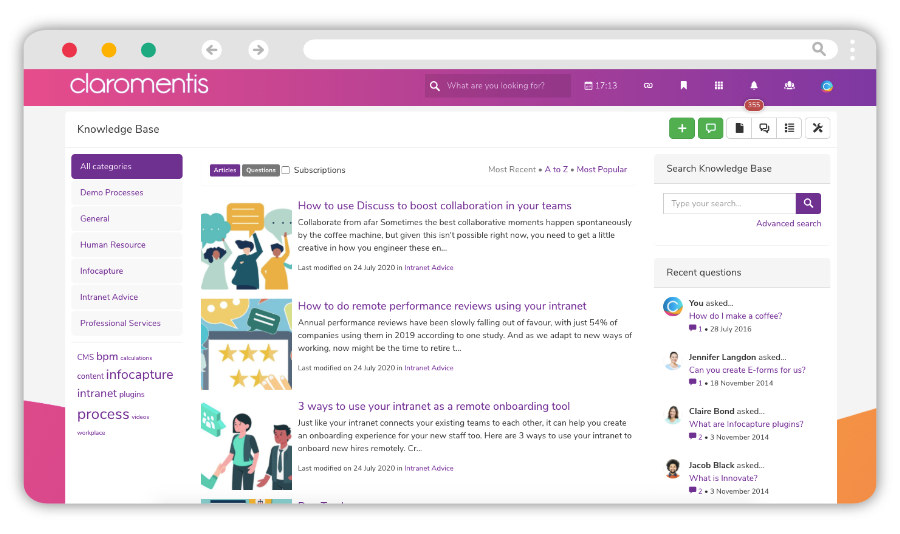Knowledge sharing – i.e., how information, skills or expertise are shared across individuals and organisations – is an essential part of business growth.
At a basic level, knowledge sharing enables your employees to learn how to log onto key systems and complete routine tasks. That said, the benefits of knowledge sharing go far beyond maintaining a basic level of operation.
Effective knowledge sharing ensures that best practices and innovative ideas aren’t siloed into separate departments. Your marketing team can benefit from insights gained by your customer service department, for example, or project managers across the business can share tips on how to motivate cross-functional teams.
In other words, knowledge sharing helps your organisation build a bank of tacit knowledge that lasts long after any individual employee has left the organisation.
Though this often goes understated, knowledge sharing has a transformational effect on employee engagement.
Why is knowledge sharing so beneficial for employee engagement?
Employees perform better when they’re engaged with their role and their organisation.
Typically, engaged employees:
- Enjoy their work and the challenges it presents
- Actively participate in company initiatives and events
- Understand and engage with the organisation’s key values
- Share tips and best practices with team members and other employees
- See opportunities for promotion and career progression at their organisation
Knowledge sharing increases engagement in all of these areas because it encourages employees to see themselves as part of a wider whole.
They can share their enjoyment of their work with others eager to learn. They can share ideas by participating in meetings or using an online knowledge sharing system. They can make new friends and professional connections by participating in discussions. And, as knowledge sharing helps develop new skills, opportunities for progression increase.

Indeed, a crucial benefit is that employees are far more likely to enjoy working in an organisation which they can contribute to on a wider, strategic level. Sharing knowledge and best practices across the organisation creates this level of employee investment – so employees are more likely to feel part of company success and less likely to leave.
How to use knowledge sharing to encourage employee engagement
Some knowledge sharing will happen organically, particularly with explicit knowledge that’s objective, process-based and easily codifiable. Your organisation wouldn’t function otherwise.
To really reap the benefits knowledge sharing offers, however, you’ll need to go above and beyond to create an environment in which innovation and best practices flow across separate knowledge bases.
Use the steps below to optimise how knowledge travels across your business.
1. Create a company culture that encourages knowledge sharing
The ease with which knowledge flows across your organisation will depend to a large extent on the company culture you engender.
Rigid, over-hierarchical workplaces result in failing to share knowledge that could spark innovative thinking elsewhere. If you expect your employees to be at their desk most of the time, if you are tracking their breaks and discouraging ‘distracting’ chit chat, you limit the potential for those spontaneous conversations in which knowledge is shared organically.
Instead, your company culture should be open, friendly and transparent. This creates an environment in which employees feel free to share, contribute and discuss their ideas with their colleagues.
You can do this by:
Adapting your physical workspace
The physical environment in which you work can encourage knowledge sharing if set up to do so. Offer ample spaces for meetings and informal catch-ups, like meeting rooms, breakout spaces, couches, coffee machines and cafeteria seating.
![[FREE GUIDE] How to Boost Employee Engagement Across Your Business](https://no-cache.hubspot.com/cta/default/5025095/5694e0cd-c681-4bb5-8551-e3868ed9f392.png)
Adopting flexible working models and avoiding micromanagement
Let your employees control their own time so long as they get results. This will result in employees that are more engaged generally, as well as greater scope for employees to make connections and share knowledge across the business on their own terms.
Encouraging strong social bonds
If your employees know each other and feel comfortable working with each other, they will share knowledge organically. A strong social scene at your place of work helps significantly here – and it doesn’t have to be large, blowout parties all the time. Heading out for a drink after a meeting, or taking interdepartmental project teams to lunch to get to know each other, are small touches that can make a huge difference.
2. Invest in tools that encourage knowledge sharing
The COVID 19 pandemic has changed the way we work.
This means you’ll need the right technology in place to create channels for dissipated workforces to share knowledge and best practice. Collaborative intranets and knowledge management systems allow you to deliver training, run discussion forums and share best practices across the business in the absence of a shared physical workspace.
Knowledge management systems help you provide formalised training to employees en masse, often in the form of webinars or e-learning modules. Meanwhile, you can use social media feeds and discussion forums provided by collaborative intranets to encourage and direct discussion around particular topics.

Use a knowledge management system to share best practices across your business
These tools also help employees develop the skills and connections required for career progression. Distinguished HR analyst Josh Bersin notes a huge growth in online learning since the pandemic began, with time previously spent commuting instead used to consume hours of online learning content.
If you can harness this desire to improve skills, you can upskill your workforce, share knowledge and increase employee engagement, all at once.
3. Revamp your onboarding and training processes
Onboarding and training are unique opportunities in the employee lifecycle to demonstrate your commitment to an individual’s development – and increase their engagement with the organisation as a result.
Setting up mentorship schemes for new hires and ongoing training opportunities through job shadowing or referral opportunities makes employees immediately more comfortable contributing ideas to their team. It also strengthens ties across the organisation, ensuring knowledge flows more easily from function to function.
This might be difficult to do right now, but, with some degree of normal on the horizon, it’s definitely worth planning for in the near future.





